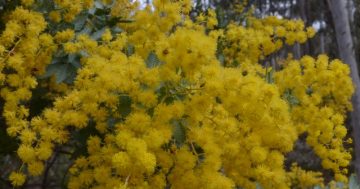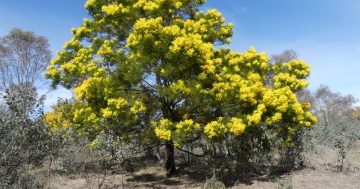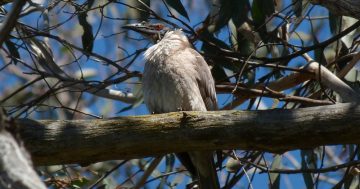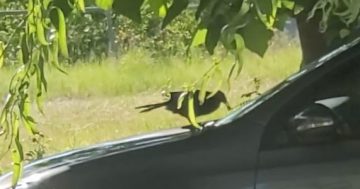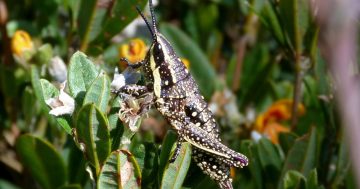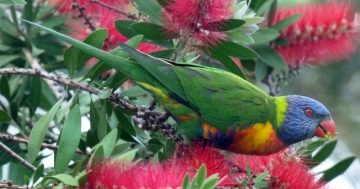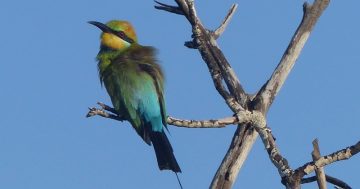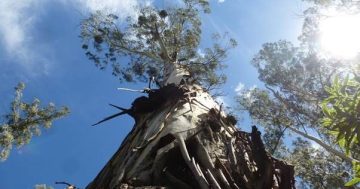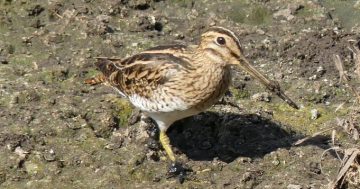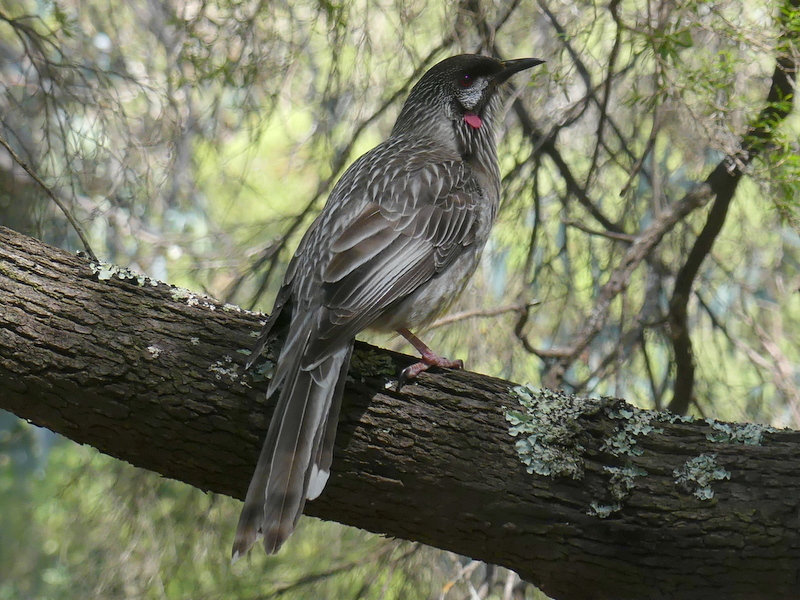
A red wattlebird showing off its red wattles in the National Botanic Gardens. Photo: Ian Fraser.
It’s an understandable source of confusion for people new to the world of birds that red wattlebirds are not red and do not have any particular association with wattle trees.
These familiar big honeyeaters owe their name to a fairly inconspicuous pair of fleshy red dangly bits of skin below and behind their eyes. These are wattles, like those of a chook, so the name would be more appropriate if it were red-wattle bird!
In fact, the great ornithologist John Gould did use the name wattled honeyeater, but it disappeared in favour of the wattlebird label, which was apparently spontaneously applied by the British colonists.
As far as I can tell, ”wattlebird” (or ”wattle bird”) first appeared in writing in 1819, by William Charles Wentworth, one of the most influential men of the early days of the colony: pastoralist, newspaper editor and politician, but probably best known for his crossing of the Blue Mountains (mostly following the path of others, it must be said).
However, in this extract, he reveals himself to be a man remarkably lacking in any awareness of his surroundings: ”In the feathered tribes of the two islands [the mainland and Tasmania], there is scarcely any diversity; of this the wattle bird, which is about the size of a snipe, and considered a very great delicacy, is the only instance which I can cite.”
In this he also reveals the reason that wattlebirds were named for the wattles that are scarcely visible from any distance: people were used to seeing them up close while handling them – before cooking them!
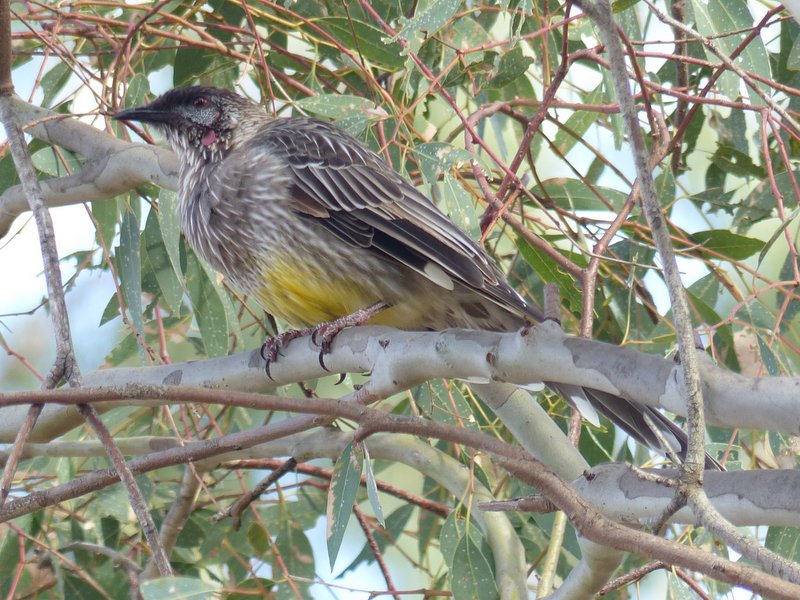
A red wattlebird demonstrating its other distinguishing features, a white triangle on the cheek and a yellow belly. Photo: Ian Fraser.
Throughout much of the 19 century, they were one of the Australian species commonly referred to as muttonbirds, and appeared regularly on hotel menus. (That name is now usually reserved for various shearwater species, whose chicks are still harvested under licence in Tasmania and New Zealand.)
However, fortunately, our interest in them now is their appearance in gardens and the bush, not on our plates! Red wattlebirds are one of the most common urban birds, here and in other southern mainland cities, and they are abundant in forests and woodlands in particular.
If you’re not familiar with them, they are medium-large brown birds with creamy streaks, a large white triangle on their cheek and a yellow belly. You will almost certainly be familiar with their voice, though, which they use constantly and loudly. It’s raucous, cackly and gobbly.
When they find a good nectar source – a bush or tree with large flowers, such as one of the popular hybrid grevilleas, a banksia or a spectacular West Australian eucalypt – they take it over and mercilessly bully smaller birds, even the tiny pardalotes, which don’t even eat the nectar. Unless you like wattlebirds to the exclusion of all others, it’s probably best to avoid these plants in planning your garden.
In former years, most red wattlebirds left the southeast and inland for winter, along with many other migratory species. Some stayed over – as large birds, they are better equipped to deal with the cold than smaller ones – and increasing numbers seem to be doing so, doubtless encouraged by milder winters. However, there is still a sudden build-up of numbers around August as the more adventurous ones return from the warmer north, though the stay-behinds have got a head-start in claiming the best breeding territories.
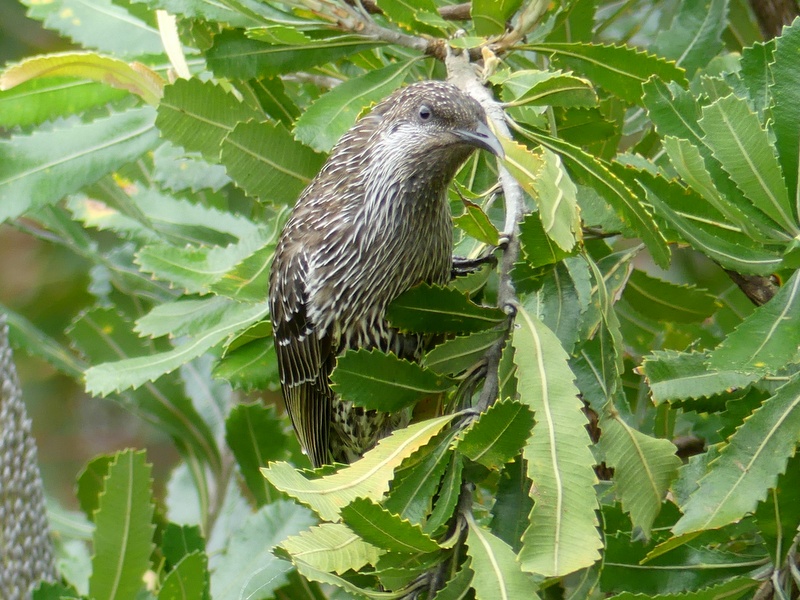
Little wattlebirds, common on the coast, are streaky and have no yellow belly – and no wattles! Photo: Ian Fraser.
Harking back to the name, there is a curious spinoff regarding two smaller wattlebird species, both near-coastal in the south-east and south-west of the country respectively. The colonists readily recognised them as being closely related to red wattlebirds and called them little, or brush, wattlebirds.
The thing is, though, these two don’t have wattles, so the name becomes meaningless. Presumably, the colonists had already forgotten the origin of the name. Anyone who frequents the coast from time to time (which surely means most of us) will be familiar with the equally raucous little wattlebirds there. A folk name for them is ”Biddyquock”, which refers to the harsh three-note call.
Wattlebirds are not the most colourful or melodious of birds, but they share our gardens and bushlands and are an important part of the bush capital landscape, helping to make it a pleasure to live in.
Original Article published by Ian Fraser on Riotact.



